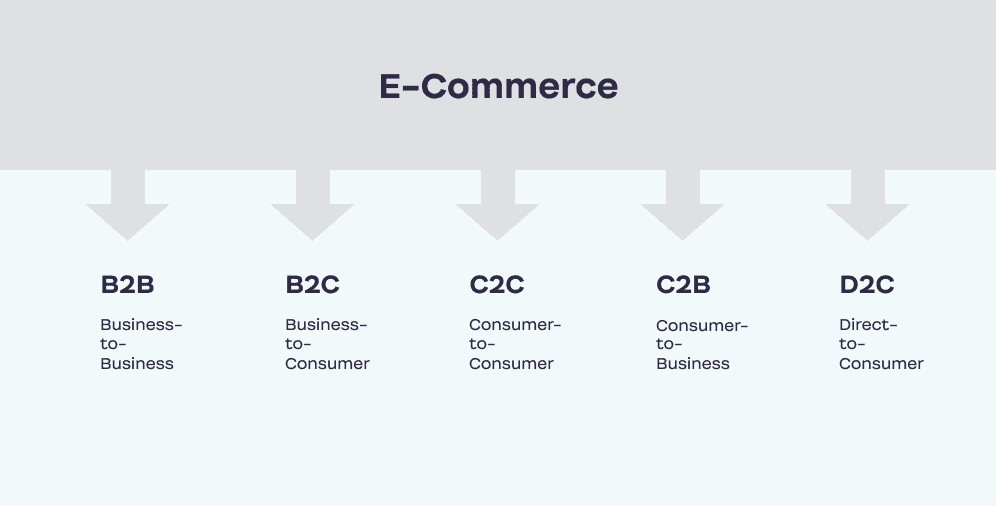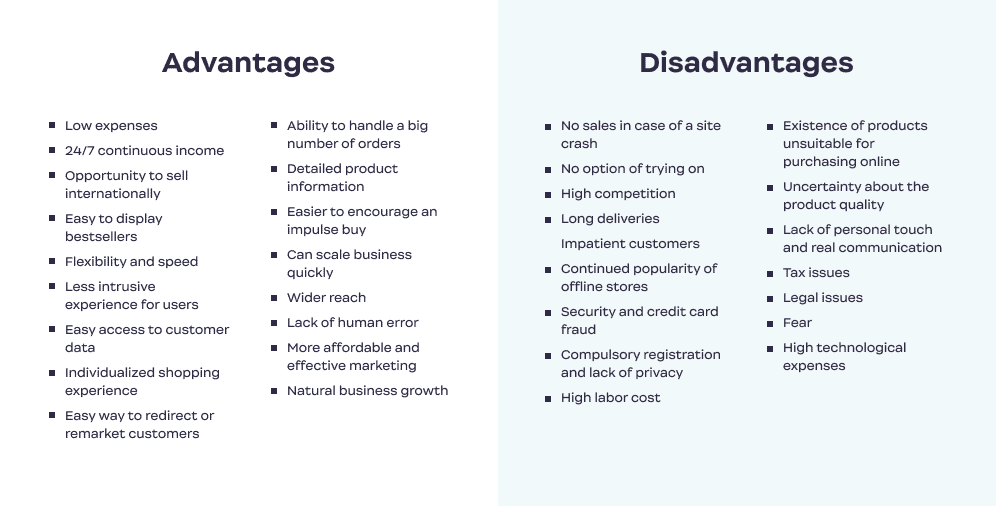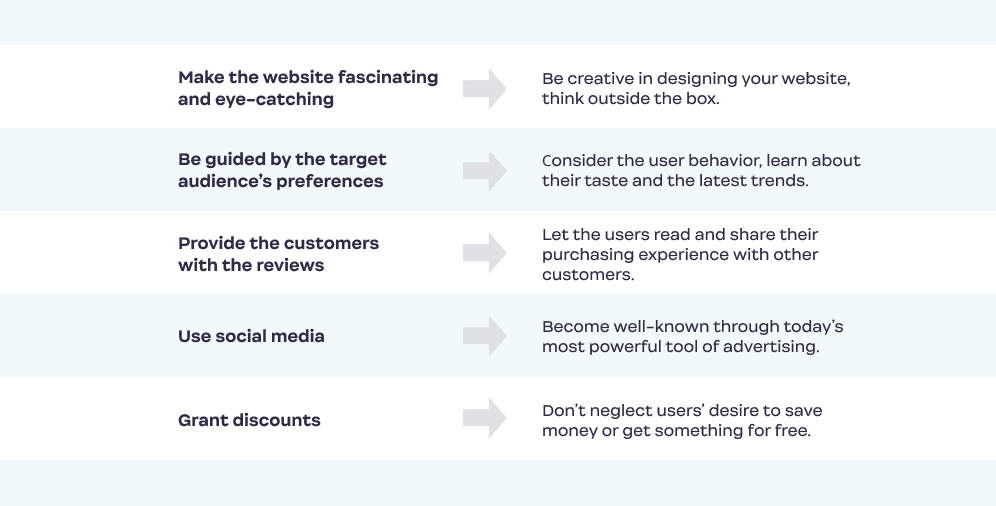Outline:
With just a single click, buying and selling various goods and services has become increasingly simple. However, this process is part of a larger business model known as e-commerce. In this article, we’ll take a closer look at this phenomenon. Most people have heard of e-commerce, and interest in it is rapidly growing every year. It’s not surprising because it’s incredibly convenient, easy, and usually inexpensive to make purchases online. By the end of this article, you’ll understand how e-commerce works, discover efficient web design strategies, learn about the advantages and disadvantages of this business model, and find out what it takes to succeed in this field.
The Pros and Cons of E-commerce: Making an Informed Decision
E-commerce refers to the process of buying and selling online. From the perspective of businesses, manufacturers, and suppliers, it involves promoting and providing services and goods via the Internet. For customers, it’s about selecting, comparing, and ordering products. Despite being relatively new, e-commerce has become a powerful tool for many companies, encompassing categories such as online sales, e-banking, ticket and hotel booking, intellectual property, and digital services. And it shows no signs of slowing down.
There are several types of e-commerce, depending on the target audience.
Business-to-business (B2B) involves commercial relations between two businesses, while business-to-consumer (B2C) refers to online sales from a company or retailer to the consumer. Consumer-to-consumer (C2C) sales are conducted between consumers on online platforms like eBay and Craigslist, while consumer-to-business (C2B) transactions occur when the customer offers the company their products or services. Finally, direct-to-consumer (D2C) is the newest type of e-commerce, allowing consumers to purchase from the manufacturer itself.
Before starting an e-commerce business, it’s important to choose the type that best suits your needs. But first, let’s look at some interesting facts about e-commerce: 72% of customers are motivated by free delivery, 77% read reviews before buying, 70% add products to their cart without completing the purchase, and 96% of Americans have made at least one online purchase. Additionally, 74% of customers rely on social networks when making a purchasing decision, and if they can’t find what they’re looking for on a website within 15 seconds, they typically leave.
While e-commerce offers many advantages, such as convenience and easy access to a global market, it also has some disadvantages, such as security risks and a lack of personal interaction. By understanding the pros and cons of e-commerce, you can make an informed decision about whether to take your business online.

18 Reasons Why Online Stores Are Cost-Effective for Entrepreneurs
It’s cheaper to set up than a regular physical store, making it an appealing option for entrepreneurs looking to start a business. By operating online, you can save money on the costs of renting a physical space, as well as expenses such as utility bills, insurance, and inventory management. Additionally, running an online store requires fewer employees than a traditional store, meaning you can save money on labor costs. In fact, in the early stages of your business, you may be able to run the store yourself or with just a few employees.
Not only is it cost-effective for the business owner, but it’s also convenient for customers. By shopping online, customers save money on travel expenses such as petrol or bus tickets, as there’s no need to physically visit a store.
Online stores have the potential for continuous income. Unlike traditional stores that have fixed hours, an online store operates 24/7. This means that potential customers who work irregular hours or stay up late can still visit your website and make purchases, allowing for a steady flow of income. By providing customers with the flexibility to order or buy something at any time, you can earn money around the clock.
Running an online store is the opportunity to sell internationally. Unlike physical stores, online businesses can reach a global audience with just a few clicks. This opens up new markets and potential customers from all over the world. However, it’s important to keep in mind that international shipping and delivery may come with additional costs and regulations.
Online stores have the ability to display bestsellers in a much more effective way than traditional stores. By showcasing these products as a separate category on the website, with reviews and feedback from satisfied customers, the online store can increase customers’ trust in these products and drive sales.
E-commerce provides maximum flexibility and speed for both customers and business owners. Customers can shop at any time, from anywhere, without the inconvenience of long queues, limited store hours, or other physical restrictions. For business owners, online stores can be easily updated and managed remotely, allowing for maximum efficiency and flexibility.
Online Store provides a less intrusive experience for users. Unlike physical stores, customers can browse products and make their own choices without feeling pressured by pushy salespeople. In the rare event that customers need assistance, they can easily contact the support team or find information in the FAQ section.
Another benefit of running an online store is easy access to customer data. When customers sign in or fill out an application form, the company can collect important information such as their name, email address, and purchase history. This information can be used to build stronger relationships with customers and personalize their shopping experience.
Online stores also have the ability to provide an individualized shopping experience for customers. By using data such as purchase history and cookies, the website can suggest products that customers might like, or offer personalized discounts and promotions. This helps to build customer loyalty and can drive sales.
Online stores have the ability to personalize the shopping experience by showing prices in customers’ local currency. This can help to eliminate confusion and create a more seamless and enjoyable experience for international customers.
Online stores have the advantage of being able to easily redirect or remarket to customers who have shown interest in a particular product but didn’t make a purchase. By adding subtle ads or reminders about the product, customers have a chance to revisit the product and make a purchase later on. This can help to increase sales and conversion rates, as well as build customer loyalty.
Running an online store is the ability to handle a large volume of orders simultaneously. In physical stores, cashiers can only process a limited number of transactions at any given time, which can lead to long lines and frustrated customers. In contrast, e-commerce stores can handle a much higher volume of orders without the need for additional cash registers or staff. This means that customers can make purchases quickly and easily, without having to wait in long lines or deal with overcrowded stores.
Online businesses have the ability to track customer behavior and preferences, which can be used to improve the overall shopping experience. By analyzing customer data such as purchase history and browsing behavior, online stores can personalize recommendations and promotions, and optimize their marketing strategies accordingly. This can help to build stronger customer relationships and increase sales over time.
Visitors are provided with detailed product information. Unlike physical stores, online stores can provide a wealth of information about products, including descriptions, images, and customer reviews. This allows visitors to make informed decisions and choose the products that best meet their needs.
Encourage impulse buying. Without the need to physically carry products home, customers may be more inclined to make additional purchases. Online stores can also use catchy images and ads to generate interest in products, and time-limited offers or countdown timers can create a sense of urgency and encourage customers to make a purchase.
Offer a wider range of products. Unlike physical stores that have limited shelf space, online stores can offer a vast array of products without worrying about storage or display limitations. This allows customers to choose from a larger selection of products and find the ones that best suit their needs.
Online stores offer convenience and accessibility for customers. Customers can shop from anywhere at any time, without the need to physically visit a store. This is particularly useful for customers who live in remote areas or have limited mobility. Additionally, online stores can offer a range of payment options, including credit cards, online payment platforms, and even cash on delivery, making it easier for customers to make purchases.
An online store offers the advantage of being able to scale your business quickly without the need for additional physical space, equipment, or personnel. When a brick-and-mortar store wants to expand its product line, it can be costly and time-consuming to acquire additional space, equipment, and staff. However, online stores have no limits in terms of square footage, making it easy and cost-effective to add new products to the store and wait for orders.
It has the ability to reach a wider audience than a brick-and-mortar store. Physical stores are limited by their location and the number of people who pass by, whereas online stores are not restricted by geographical boundaries. This means that an online store can potentially reach thousands of customers from all over the world, expanding its customer base and driving sales.
Automation is another advantage of e-commerce, as it minimizes the risk of human error. Human mistakes can lead to customer dissatisfaction, lost revenue, and damage to the business’s reputation. By automating processes such as inventory management, order fulfillment, and payment processing, an online store can reduce the risk of errors and ensure a smoother, more efficient shopping experience for customers.
Overcoming Customer Fear in E-Commerce: Building Confidence in Online Shopping
When it comes to online businesses, the website is the only thing you have. If it crashes, your business comes to a standstill, preventing customers from making purchases and resulting in lost income. This highlights the fact that e-commerce businesses are completely dependent on web platforms.
Therefore, it’s crucial to choose a reliable platform for running your business and not base your decision solely on price. Cheaper services may be more likely to experience frequent crashes that can negatively impact your company’s operations. Trustworthy e-commerce platforms include Shopify, WooCommerce, Magento, and BigCommerce. Additionally, it’s essential to monitor your website’s performance closely and react quickly in the event of a crash to minimize downtime and revenue loss.
One of the challenges of online shopping is that customers can’t try products on before buying them. In brick-and-mortar stores, customers can try samples of products to see if they like them. However, online customers lack the physical ability to interact with the products. Nevertheless, augmented reality tools are now available that allow customers to virtually “touch” a product before making a purchase. Some companies also offer a “free returns” function if the customer tries the product and doesn’t like it. However, this approach can lead to an increase in returns.
The world of e-commerce is incredibly competitive, and even before the pandemic, it was a significant challenge to establish a foothold in the market, which is growing exponentially. Depending on the business sector, your company may face numerous competitors. To succeed, you need to be unique, creative, and precise in everything you do. Moreover, if your e-commerce business operates in a highly competitive niche, you may need to invest heavily in advertising and marketing to stand out from the crowd.
One downside of online shopping is the risk of long delivery times. While customers may be primarily concerned with the price of a product when placing an order, they may not pay much attention to the delivery terms. Unlike physical stores, where customers can pay and receive their purchases immediately, online companies cannot provide this immediate gratification (unless it’s an intangible product). There is also the risk of lost packages during shipment or borders closing for an indefinite period, resulting in delayed or undelivered orders. The best solution is to be honest with customers about delivery times and potential risks.
Customers can be incredibly impatient when it comes to online shopping. Inexperienced customers, in particular, may have various questions about payment details, product quality, or delivery terms and expect prompt responses. Unlike in physical stores, where customers can get help from shop assistants immediately, online stores need to have a dedicated support team to ensure quick and efficient responses to customer queries.
Despite the rapid growth of e-commerce, there are still many customers who prefer traditional shopping due to a lack of trust in buying online or as a leisure activity. This means that solely relying on an online store may result in missing out on potential customers. To address this, many companies are opting to have both offline and online stores to cater to all types of shoppers. Amazon, for example, has started to invest in brick-and-mortar stores as well. However, such a modernization process requires significant investment, making it more accessible to wealthy companies with resources to spare.
Risks are an integral part of any kind of business. The biggest risk for brick-and-mortar shops is robbery. For online shopping, customers need to sign in and provide the company with their personal information, including their bank details. Unfortunately, cases of hacking and information leaks are not rare, and e-commerce companies should take the responsibility and risk of security breaches seriously. The security of customers’ data is a crucial aspect that companies should consider and take all available precautionary measures to ensure the safety of customers’ personal information. While it may cost the company a lot, the risk of losing the whole business should motivate them to prioritize security.
Due to the risk of security breaches, some people are not keen on sharing their personal information through registration. They do not want their information to be disclosed to third parties, and e-commerce companies should respect that. To address this concern, companies can offer the option for customers to purchase as a guest, without the obligation to register.
Certain product categories are difficult to purchase online, such as jewelry, clothes, shoes, and perishable products. Customers need to try on these products before deciding to buy them, making it hard to purchase them online. Pictures and tables with sizes provided are not enough, and customers need more information before making a decision. These types of products are also challenging to choose offline, as it takes a lot of time to find the right product, size, and price.
Despite being provided with a detailed product description and pictures, there’s absolutely no guarantee that the delivered product will meet the customer’s expectations. Even reviews cannot ensure that the customers will be satisfied with their order, leaving them with a sense of uncertainty. In such cases, the company’s reputation plays a decisive role. If the store has a history of delivering broken or spoiled goods, delivering the wrong products, or failing to meet customer expectations, it will negatively impact the company’s image, making customers more uncertain about their purchases.
There’s a lack of personal touch and real communication. This point refers to several aspects, including the inability to touch, smell, or taste products before buying, which is particularly important for certain product categories such as perfume, food, or furniture. Additionally, there is a lack of interaction with sellers or consultants, who are often relied on for their professional advice on products.
Furthermore, for some customers, shopping is a source of relaxation, entertainment, or socializing, making it a more enjoyable and fulfilling experience than shopping online. While e-commerce companies do have support teams, nothing can replace the value of face-to-face communication and the personal touch provided by brick-and-mortar stores.
You’ll have to deal with tricky tax issues. If you want to become the owner of a global company, you need to consider tax regulations not just in your own country, but in all the countries and states where you operate, as taxes differ from region to region. Therefore, you should calculate your prices reasonably in advance and ensure that you comply with tax laws, as conducting e-commerce business may become unprofitable. This point may be regarded as the most critical one.
Since an e-commerce store is a legal entity, you should be fully aware of all laws and regulations concerning buying and selling products to start running it. That includes not only your rights and obligations, but also those of your customers. Moreover, there are many differences between conducting business online and offline that you should consider to avoid unpleasant situations. Additionally, legal systems are not as fast in their development as technologies, and therefore, some companies create their own regulations without government participation.
Customers experience fear while purchasing online. One reason behind traditional shops’ popularity is that there’s no surprise element. Customers can see and touch the product and promptly get information on it. Therefore, there’s no fear of choosing the wrong color, size, or material. Besides, customers are not required to give their personal data or credit card numbers to buy something. They pay and receive the product immediately, without delays. In traditional shops, they do almost everything themselves, giving them a feeling of control, which they lack when dealing with online stores.
The e-commerce industry relies heavily on technology to ensure continuous workflow. To achieve this, companies must invest in good equipment, constantly update programs and software, and work with advanced platforms and servers, all of which require significant financial investment.
Furthermore, highly qualified employees are essential to the success of e-commerce businesses. The skill set required for online shops is vastly different from that required for physical stores, with tech-savvy and experienced employees commanding higher salaries. To remain competitive, companies must invest in their employees’ training.
By considering both the advantages and disadvantages, you can gain a complete understanding of the e-commerce industry. Ultimately, it’s up to you to decide whether the glass is half empty or half full and whether e-commerce is the right choice for your business.

Standing Out in a Crowded Online Marketplace: How to Make Your Website Eye-Catching
After considering the advantages and disadvantages, you’ve decided to start your online business. Now, you must attract and retain customers to make it work. Here are some tips for doing so:
- Make your website eye-catching and fascinating. The website is the face of your company, so it must stand out. Use custom visuals, incorporate your brand style, and be creative. However, ensure consistency to ensure your recognizability.
- Be guided by your target audience’s preferences. If you sell products for women, men, or specific countries, stay up to date with the latest trends. This helps you to decide and include only in-demand products on your list.
- Provide customers with reviews. Before making a purchase, the majority of customers want to know about the experience of previous customers. You should also provide an opportunity for customers to leave their own reviews.
- Utilize social media to promote your brand and reach a wider audience. Instagram and Facebook are two of the most popular social media platforms, so make sure to take advantage of them to display your products and services.
- Offer discounts and special offers to catch the attention of potential customers. Everyone loves a good deal, so consider providing new customers with a discount on their first purchase or offering a free product with a purchase.
- Provide reviews from previous customers to help build trust and confidence in your brand. This can also help you improve your products and services by taking feedback into consideration.
- Tailor your products to the preferences of your target audience. If you sell products for a specific gender or country, stay updated with the latest trends and include products that are in high demand.
- Make your website fascinating and eye-catching to leave a lasting impression on visitors. Use custom visuals and incorporate your brand style, but ensure consistency to maintain brand recognition.
Implementing these tips can help you attract and retain customers, ultimately leading to the success of your online business.

On a Final Note
In this article, our B2B website design agency has provided you with the most crucial facts about the challenging yet super trendy world of e-commerce. It has its advantages, which make people think about starting their successful business there. But, we mustn’t forget about its disadvantages, which may be a major turnoff for some.
However, e-commerce is certainly a thing to be considered, and it’s up to you to decide whether it’s a suitable way for running your business. We hope that you have gained valuable insights on this topical issue.
If you are captivated by e-commerce but still have questions, feel free to contact us, and our Ester professionals will do their best to help you.




